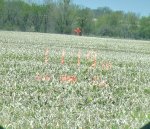Hello forum,
I have for the most part all of the equipment I need to start shooting at long range, such as a good rifle, scope, spotting scope and handloads ready, and I just need a range finder for when I’m in the mountains. I know I can calculate distance by using height of the target and things like that through the reticle or my scope, but I’m willing to pay for a laser rangefinder to make the process quicker and easier, and so that when hunting I don’t have to find the height of the average animal in an area from my tower or position. What would be some of the best laser range finders that can go out to let’s say 1000 yards that don’t cost too much money?
Thanks.
I have for the most part all of the equipment I need to start shooting at long range, such as a good rifle, scope, spotting scope and handloads ready, and I just need a range finder for when I’m in the mountains. I know I can calculate distance by using height of the target and things like that through the reticle or my scope, but I’m willing to pay for a laser rangefinder to make the process quicker and easier, and so that when hunting I don’t have to find the height of the average animal in an area from my tower or position. What would be some of the best laser range finders that can go out to let’s say 1000 yards that don’t cost too much money?
Thanks.



